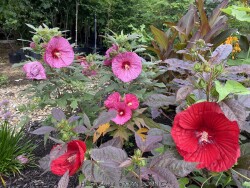

Hardy Hibiscus are US native plants that feature very large single petal flowers sometimes as large as a dinner plate. Colors include white, pink, red, magenta, purple with many different combinations. Foliage can range from green to reddish to dark purplish black. Hardy hibiscus breeding to produce improved cultivars has come a long way in the last 10 or 20 years. Hibiscus emerge later than most other perennials, needing the ground to heat up before growing in May. Hibiscus tolerate a wide range of soil conditions including clay and wetness but prefer rich garden soil. Drought is tolerated with established plants although flowering will be reduced. Generally, the 40 inches of rainfall in Eastern Kansas is sufficient. Full sun is best for optimal foliage coloring, growth habit, and flowers. When used in a landscape, hibiscus brings a tropical feel when flowering and are noticeable from very far away. Combine with hardy bananas (musa basjoo) and other contrasting flowers. Groupings of hibiscus are very effective around water gardens, rain gardens, backyard fences, pollinator gardens, and roadside areas where you only have a second to look when driving by. Modern hibiscus cultivars do not set seed and do not need to be deadheaded like old varieties; the result is continuous blooming from July till September. Cool autumn nights below 50 degrees F initiate beautiful fall foliage colors ranging from red and purple to fiery orange. Maintenance is pretty easy: just cut down dead stocks to the ground at some point in fall or winter. A yearly time-release fertilizer is appreciated from most heavily flowering plants. There are some occasional foliage pests for hibiscuses including leaf miners, grasshoppers, and Japanese beetles but these can be treated. If not treated, it generally won't kill the plant, especially if the plant is otherwise healthy and in good growing conditions.
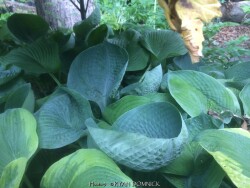

Hosta by far is the most popular and well-known shade plant in the United States. Many thousands of cultivars exist from original species native to China, Japan, and other forested areas in Asia. Hosta foliage arises from a clump-forming root system and is often large and dramatic with many types of variegation. Flowers, born on tall stocks ranging in shades of white and purple, are equally attractive. Hostas grow best in rich, well-drained soils in full to partial shade. In Eastern Kansas with our average 40 inches of average rainfall, plants are drought tolerant if established in moisture-retentive high-quality soil. Dry-shade areas are best avoided. Afternoon sun with temperatures over 95 degrees F but likely burn the tips of hosta foliage rendering them unattractive for the rest of the year. There is no secondary growth by late summer after flowering and after buds have been set for next year. In northern parts of the country, hostas can handle full sun. In the Southern part of their range further South than zone 7, hosta can really struggle through the long summer heat unless conditions are perfect. Rabbits, deer, slugs, and snails can be a problem generally on small or un-established plants. Large-leaf robust varieties seem to outgrow browsing predators better than small dainty varieties. Methods of control are effective ranging from cages to deer repellents. Generally, a large established planting of hostas will be there for decades gradually getting thicker and denser without a need to divide. Many plantings have been in our display garden for 15-20 years with no weeds ever trying to grow in the shade of the foliage. Hosta foliage is susceptible to late spring freezes so try to cover if possible. During the Easter freeze of April, 2007, thousands of hosta were killed to the ground in eastern Kansas but all returned successfully by May from secondary buds. Hosta's newly unfurling foliage is considered edible when cooked like asparagus or eaten raw in salads. Hosta 'Abiqua Drinking Gourd' is a medium (large) puckered, powder-blue leaves with chalky undersides are uniquely upward facing and deeply cupped. White flowers bloom midsummer; very slug resistant.
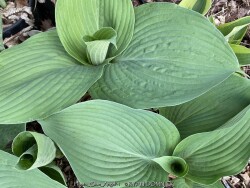

Hosta by far is the most popular and well-known shade plant in the United States. Many thousands of cultivars exist from original species native to China, Japan, and other forested areas in Asia. Hosta foliage arrises from a clump-forming root system and is often large and dramatic with many types of variegation. Flowers, born on tall stocks ranging in shades of white and purple, are equally attractive. Hostas grow best in rich, well-drained soils in full to partial shade. In Eastern Kansas with our average 40 inches of average rainfall, plants are drought tolerant if established in moisture-retentive high-quality soil. Dry-shade areas are best avoided. Afternoon sun with temperatures over 95 degrees F but likely burn the tips of hosta foliage rendering them unattractive for the rest of the year. There is no secondary growth by late summer after flowering and after buds have been set for next year. In northern parts of the country, hostas can handle full sun. In the Southern part of their range further South than zone 7, hosta can really struggle through the long summer heat unless conditions are perfect. Rabbits, deer, slugs, and snails can be a problem generally on small or un-established plants. Large-leaf robust varieties seem to outgrow browsing predators better than small dainty varieties. Methods of control are effective ranging from cages to deer repellents. Generally, a large established planting of hostas will be there for decades gradually getting thicker and denser without a need to divide. Many plantings have been in our display garden for 15-20 years with no weeds ever trying to grow in the shade of the foliage. Hosta foliage is susceptible to late spring freezes so try to cover if possible. During the Easter freeze of April, 2007, thousands of hosta were killed to the ground in eastern Kansas but all returned successfully by May from secondary buds. Hosta's newly unfurling foliage is considered edible when cooked like asparagus or eaten raw in salads. Hosta 'Blue Angel' features giant, heart-shaped blue-green heavily textured leaves under dense hyacinth-like white flowers.
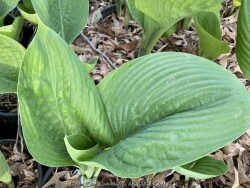

Hosta by far is the most popular and well-known shade plant in the United States. Many thousands of cultivars exist from original species native to China, Japan, and other forested areas in Asia. Hosta foliage arrises from a clump-forming root system and is often large and dramatic with many types of variegation. Flowers, born on tall stocks ranging in shades of white and purple, are equally attractive. Hostas grow best in rich, well-drained soils in full to partial shade. In Eastern Kansas with our average 40 inches of average rainfall, plants are drought tolerant if established in moisture-retentive high-quality soil. Dry-shade areas are best avoided. Afternoon sun with temperatures over 95 degrees F but likely burn the tips of hosta foliage rendering them unattractive for the rest of the year. There is no secondary growth by late summer after flowering and after buds have been set for next year. In northern parts of the country, hostas can handle full sun. In the Southern part of their range further South than zone 7, hosta can really struggle through the long summer heat unless conditions are perfect. Rabbits, deer, slugs, and snails can be a problem generally on small or un-established plants. Large-leaf robust varieties seem to outgrow browsing predators better than small dainty varieties. Methods of control are effective ranging from cages to deer repellents. Generally, a large established planting of hostas will be there for decades gradually getting thicker and denser without a need to divide. Many plantings have been in our display garden for 15-20 years with no weeds ever trying to grow in the shade of the foliage. Hosta foliage is susceptible to late spring freezes so try to cover if possible. During the Easter freeze of April, 2007, thousands of hosta were killed to the ground in eastern Kansas but all returned successfully by May from secondary buds. Hosta's newly unfurling foliage is considered edible when cooked like asparagus or eaten raw in salads. Hosta 'Blue Angel' features giant, heart-shaped blue-green heavily textured leaves under dense hyacinth-like white flowers.
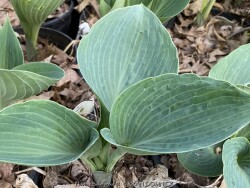

Hosta by far is the most popular and well-known shade plant in the United States. Many thousands of cultivars exist from original species native to China, Japan, and other forested areas in Asia. Hosta foliage arrises from a clump-forming root system and is often large and dramatic with many types of variegation. Flowers, born on tall stocks ranging in shades of white and purple, are equally attractive. Hostas grow best in rich, well-drained soils in full to partial shade. In Eastern Kansas with our average 40 inches of average rainfall, plants are drought tolerant if established in moisture-retentive high-quality soil. Dry-shade areas are best avoided. Afternoon sun with temperatures over 95 degrees F but likely burn the tips of hosta foliage rendering them unattractive for the rest of the year. There is no secondary growth by late summer after flowering and after buds have been set for next year. In northern parts of the country, hostas can handle full sun. In the Southern part of their range further South than zone 7, hosta can really struggle through the long summer heat unless conditions are perfect. Rabbits, deer, slugs, and snails can be a problem generally on small or un-established plants. Large-leaf robust varieties seem to outgrow browsing predators better than small dainty varieties. Methods of control are effective ranging from cages to deer repellents. Generally, a large established planting of hostas will be there for decades gradually getting thicker and denser without a need to divide. Many plantings have been in our display garden for 15-20 years with no weeds ever trying to grow in the shade of the foliage. Hosta foliage is susceptible to late spring freezes so try to cover if possible. During the Easter freeze of April, 2007, thousands of hosta were killed to the ground in eastern Kansas but all returned successfully by May from secondary buds. Hosta's newly unfurling foliage is considered edible when cooked like asparagus or eaten raw in salads. Hosta 'Bulletproof' has extremely thick blue leaves that look good all season: very resistant to slugs and snails. Sport of 'Halcyon'
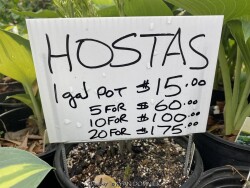

Hosta by far is the most popular and well-known shade plant in the United States. Many thousands of cultivars exist from original species native to China, Japan, and other forested areas in Asia. Hosta foliage arrises from a clump-forming root system and is often large and dramatic with many types of variegation. Flowers, born on tall stocks ranging in shades of white and purple, are equally attractive. Hostas grow best in rich, well-drained soils in full to partial shade. In Eastern Kansas with our average 40 inches of average rainfall, plants are drought tolerant if established in moisture-retentive high-quality soil. Dry-shade areas are best avoided. Afternoon sun with temperatures over 95 degrees F but likely burn the tips of hosta foliage rendering them unattractive for the rest of the year. There is no secondary growth by late summer after flowering and after buds have been set for next year. In northern parts of the country, hostas can handle full sun. In the Southern part of their range further South than zone 7, hosta can really struggle through the long summer heat unless conditions are perfect. Rabbits, deer, slugs, and snails can be a problem generally on small or un-established plants. Large-leaf robust varieties seem to outgrow browsing predators better than small dainty varieties. Methods of control are effective ranging from cages to deer repellents. Generally, a large established planting of hostas will be there for decades gradually getting thicker and denser without a need to divide. Many plantings have been in our display garden for 15-20 years with no weeds ever trying to grow in the shade of the foliage. Hosta foliage is susceptible to late spring freezes so try to cover if possible. During the Easter freeze of April, 2007, thousands of hosta were killed to the ground in eastern Kansas but all returned successfully by May from secondary buds. Hosta's newly unfurling foliage is considered edible when cooked like asparagus or eaten raw in salads. Hosta 'Dream Queen' is a medium; a slightly smaller version of Great Expectations with improved bold variegation. Puckered heart-shaped leaves have wider blue-green margin and creamy yellow centers; white blossoms; excellent substance. Fast grower with more sun tolerance
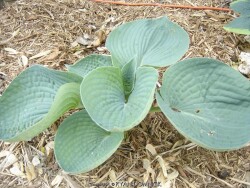

Hosta by far is the most popular and well-known shade plant in the United States. Many thousands of cultivars exist from original species native to China, Japan, and other forested areas in Asia. Hosta foliage arrises from a clump-forming root system and is often large and dramatic with many types of variegation. Flowers, born on tall stocks ranging in shades of white and purple, are equally attractive. Hostas grow best in rich, well-drained soils in full to partial shade. In Eastern Kansas with our average 40 inches of average rainfall, plants are drought tolerant if established in moisture-retentive high-quality soil. Dry-shade areas are best avoided. Afternoon sun with temperatures over 95 degrees F but likely burn the tips of hosta foliage rendering them unattractive for the rest of the year. There is no secondary growth by late summer after flowering and after buds have been set for next year. In northern parts of the country, hostas can handle full sun. In the Southern part of their range further South than zone 7, hosta can really struggle through the long summer heat unless conditions are perfect. Rabbits, deer, slugs, and snails can be a problem generally on small or un-established plants. Large-leaf robust varieties seem to outgrow browsing predators better than small dainty varieties. Methods of control are effective ranging from cages to deer repellents. Generally, a large established planting of hostas will be there for decades gradually getting thicker and denser without a need to divide. Many plantings have been in our display garden for 15-20 years with no weeds ever trying to grow in the shade of the foliage. Hosta foliage is susceptible to late spring freezes so try to cover if possible. During the Easter freeze of April, 2007, thousands of hosta were killed to the ground in eastern Kansas but all returned successfully by May from secondary buds. Hosta's newly unfurling foliage is considered edible when cooked like asparagus or eaten raw in salads. Hosta 'Earth Angel' Giant; this spectacular new sport from Blue Angel has huge blue-green pointed leaves with wide creamy white margins. Thick leaves have good substance and deep attractive ribs. Pale lavender flowers bloom midsummer. Very impressive mature clumps can reach 5' across.
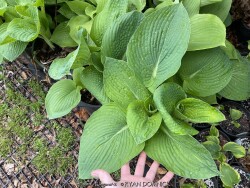

Hosta by far is the most popular and well-known shade plant in the United States. Many thousands of cultivars exist from original species native to China, Japan, and other forested areas in Asia. Hosta foliage arrises from a clump-forming root system and is often large and dramatic with many types of variegation. Flowers, born on tall stocks ranging in shades of white and purple, are equally attractive. Hostas grow best in rich, well-drained soils in full to partial shade. In Eastern Kansas with our average 40 inches of average rainfall, plants are drought tolerant if established in moisture-retentive high-quality soil. Dry-shade areas are best avoided. Afternoon sun with temperatures over 95 degrees F but likely burn the tips of hosta foliage rendering them unattractive for the rest of the year. There is no secondary growth by late summer after flowering and after buds have been set for next year. In northern parts of the country, hostas can handle full sun. In the Southern part of their range further South than zone 7, hosta can really struggle through the long summer heat unless conditions are perfect. Rabbits, deer, slugs, and snails can be a problem generally on small or un-established plants. Large-leaf robust varieties seem to outgrow browsing predators better than small dainty varieties. Methods of control are effective ranging from cages to deer repellents. Generally, a large established planting of hostas will be there for decades gradually getting thicker and denser without a need to divide. Many plantings have been in our display garden for 15-20 years with no weeds ever trying to grow in the shade of the foliage. Hosta foliage is susceptible to late spring freezes so try to cover if possible. During the Easter freeze of April, 2007, thousands of hosta were killed to the ground in eastern Kansas but all returned successfully by May from secondary buds. Hosta's newly unfurling foliage is considered edible when cooked like asparagus or eaten raw in salads. Hosta 'Elegans' is an older variety with giant heart-shaped heavily puckered blue-gray leaves are pest resistant. Near white flowers on short scapes.
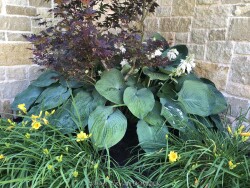

Hosta by far is the most popular and well-known shade plant in the United States. Many thousands of cultivars exist from original species native to China, Japan, and other forested areas in Asia. Hosta foliage arrises from a clump-forming root system and is often large and dramatic with many types of variegation. Flowers, born on tall stocks ranging in shades of white and purple, are equally attractive. Hostas grow best in rich, well-drained soils in full to partial shade. In Eastern Kansas with our average 40 inches of average rainfall, plants are drought tolerant if established in moisture-retentive high-quality soil. Dry-shade areas are best avoided. Afternoon sun with temperatures over 95 but likely burn the tips of hosta foliage rendering them unattractive for the rest of the year. There is no secondary growth by late summer after flowering and after buds have been set for next year. In northern parts of the country, hostas can handle full sun. In the Southern part of their range further South than zone 7, hosta can really struggle through the long summer heat unless conditions are perfect. Rabbits, deer, slugs, and snails can be a problem generally on small or un-established plants. Large-leaf robust varieties seem to outgrow browsing predators better than small dainty varieties. Methods of control are effective ranging from cages to deer repellents. Generally, a large established planting of hostas will be there for decades gradually getting thicker and denser without a need to divide. Many plantings have been in our display garden for 15-20 years with no weeds ever trying to grow in the shade of the foliage. Hosta foliage is susceptible to late spring freezes so try to cover if possible. During the Easter freeze of April, 2007, thousands of hosta were killed to the ground in eastern Kansas but all returned successfully by May from secondary buds. Hosta's newly unfurling foliage is considered edible when cooked like asparagus or eaten raw in salads. Shadowland® 'Empress Wu' is the largest known hosta available! This massive plant forms a gigantic upright mound of huge, thick, dark green leaves topped with pale reddish violet flowers. It will make a fantastic statement in your shade garden! All Proven Winners® plants are legally propagated, healthy and vigorous, true to name, and tagged with color pictures and growing information.
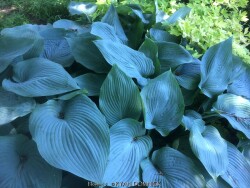

Hosta by far is the most popular and well-known shade plant in the United States. Many thousands of cultivars exist from original species native to China, Japan, and other forested areas in Asia. Hosta foliage arrises from a clump-forming root system and is often large and dramatic with many types of variegation. Flowers, born on tall stocks ranging in shades of white and purple, are equally attractive. Hostas grow best in rich, well-drained soils in full to partial shade. In Eastern Kansas with our average 40 inches of average rainfall, plants are drought tolerant if established in moisture-retentive high-quality soil. Dry-shade areas are best avoided. Afternoon sun with temperatures over 95 degrees F but likely burn the tips of hosta foliage rendering them unattractive for the rest of the year. There is no secondary growth by late summer after flowering and after buds have been set for next year. In northern parts of the country, hostas can handle full sun. In the Southern part of their range further South than zone 7, hosta can really struggle through the long summer heat unless conditions are perfect. Rabbits, deer, slugs, and snails can be a problem generally on small or un-established plants. Large-leaf robust varieties seem to outgrow browsing predators better than small dainty varieties. Methods of control are effective ranging from cages to deer repellents. Generally, a large established planting of hostas will be there for decades gradually getting thicker and denser without a need to divide. Many plantings have been in our display garden for 15-20 years with no weeds ever trying to grow in the shade of the foliage. Hosta foliage is susceptible to late spring freezes so try to cover if possible. During the Easter freeze of April, 2007, thousands of hosta were killed to the ground in eastern Kansas but all returned successfully by May from secondary buds. Hosta's newly unfurling foliage is considered edible when cooked like asparagus or eaten raw in salads. Hosta 'Halcyon' is a medium height cultivar. It features spearhead-shaped chalky-blue leaves with heavy ribbing and pale lavender flowers. Thick substance, pest resistant, tolerates partial sun.
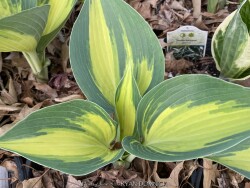

Hosta by far is the most popular and well-known shade plant in the United States. Many thousands of cultivars exist from original species native to China, Japan, and other forested areas in Asia. Hosta foliage arrises from a clump-forming root system and is often large and dramatic with many types of variegation. Flowers, born on tall stocks ranging in shades of white and purple, are equally attractive. Hostas grow best in rich, well-drained soils in full to partial shade. In Eastern Kansas with our average 40 inches of average rainfall, plants are drought tolerant if established in moisture-retentive high-quality soil. Dry-shade areas are best avoided. Afternoon sun with temperatures over 95 degrees F but likely burn the tips of hosta foliage rendering them unattractive for the rest of the year. There is no secondary growth by late summer after flowering and after buds have been set for next year. In northern parts of the country, hostas can handle full sun. In the Southern part of their range further South than zone 7, hosta can really struggle through the long summer heat unless conditions are perfect. Rabbits, deer, slugs, and snails can be a problem generally on small or un-established plants. Large-leaf robust varieties seem to outgrow browsing predators better than small dainty varieties. Methods of control are effective ranging from cages to deer repellents. Generally, a large established planting of hostas will be there for decades gradually getting thicker and denser without a need to divide. Many plantings have been in our display garden for 15-20 years with no weeds ever trying to grow in the shade of the foliage. Hosta foliage is susceptible to late spring freezes so try to cover if possible. During the Easter freeze of April, 2007, thousands of hosta were killed to the ground in eastern Kansas but all returned successfully by May from secondary buds. Hosta's newly unfurling foliage is considered edible when cooked like asparagus or eaten raw in salads. Hosta 'June' is a medium height cultivar. It features small (medium) spearhead-shaped leaves with irregular blue-green edges, chartreuse centers fading to white; lavender flowers. Heavy substance, slug resistant; tolerates partial sun.
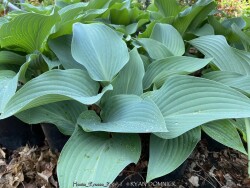

Hosta by far is the most popular and well-known shade plant in the United States. Many thousands of cultivars exist from original species native to China, Japan, and other forested areas in Asia. Hosta foliage arrises from a clump-forming root system and is often large and dramatic with many types of variegation. Flowers, born on tall stocks ranging in shades of white and purple, are equally attractive. Hostas grow best in rich, well-drained soils in full to partial shade. In Eastern Kansas with our average 40 inches of average rainfall, plants are drought tolerant if established in moisture-retentive high-quality soil. Dry-shade areas are best avoided. Afternoon sun with temperatures over 95 degrees F but likely burn the tips of hosta foliage rendering them unattractive for the rest of the year. There is no secondary growth by late summer after flowering and after buds have been set for next year. In northern parts of the country, hostas can handle full sun. In the Southern part of their range further South than zone 7, hosta can really struggle through the long summer heat unless conditions are perfect. Rabbits, deer, slugs, and snails can be a problem generally on small or un-established plants. Large-leaf robust varieties seem to outgrow browsing predators better than small dainty varieties. Methods of control are effective ranging from cages to deer repellents. Generally, a large established planting of hostas will be there for decades gradually getting thicker and denser without a need to divide. Many plantings have been in our display garden for 15-20 years with no weeds ever trying to grow in the shade of the foliage. Hosta foliage is susceptible to late spring freezes so try to cover if possible. During the Easter freeze of April, 2007, thousands of hosta were killed to the ground in eastern Kansas but all returned successfully by May from secondary buds. Hosta's newly unfurling foliage is considered edible when cooked like asparagus or eaten raw in salads. Hosta 'Krossa Regal' is a large to giant hosta that grows in an upright, vase-shaped habit. Foliage is thick, waxy, pest resistant, and powdery-blue. Trumpet-shaped, lavender flowers bloom in mid to late summer on tall stalks.
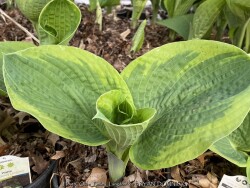

Hosta by far is the most popular and well-known shade plant in the United States. Many thousands of cultivars exist from original species native to China, Japan, and other forested areas in Asia. Hosta foliage arrises from a clump-forming root system and is often large and dramatic with many types of variegation. Flowers, born on tall stocks ranging in shades of white and purple, are equally attractive. Hostas grow best in rich, well-drained soils in full to partial shade. In Eastern Kansas with our average 40 inches of average rainfall, plants are drought tolerant if established in moisture-retentive high-quality soil. Dry-shade areas are best avoided. Afternoon sun with temperatures over 95 degrees F but likely burn the tips of hosta foliage rendering them unattractive for the rest of the year. There is no secondary growth by late summer after flowering and after buds have been set for next year. In northern parts of the country, hostas can handle full sun. In the Southern part of their range further South than zone 7, hosta can really struggle through the long summer heat unless conditions are perfect. Rabbits, deer, slugs, and snails can be a problem generally on small or un-established plants. Large-leaf robust varieties seem to outgrow browsing predators better than small dainty varieties. Methods of control are effective ranging from cages to deer repellents. Generally, a large established planting of hostas will be there for decades gradually getting thicker and denser without a need to divide. Many plantings have been in our display garden for 15-20 years with no weeds ever trying to grow in the shade of the foliage. Hosta foliage is susceptible to late spring freezes so try to cover if possible. During the Easter freeze of April, 2007, thousands of hosta were killed to the ground in eastern Kansas but all returned successfully by May from secondary buds. Hosta's newly unfurling foliage is considered edible when cooked like asparagus or eaten raw in salads. Hosta 'Olive Bailey Langdon' is a large variety. Considered an improved Frances Williams with better color and less prone to burning. Large rounded leaves with powder blue centers and wide irregular gold margins under white blossoms; heavily corrugated with thick substance.
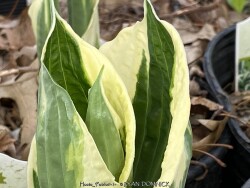

Hosta by far is the most popular and well-known shade plant in the United States. Many thousands of cultivars exist from original species native to China, Japan, and other forested areas in Asia. Hosta foliage arrises from a clump-forming root system and is often large and dramatic with many types of variegation. Flowers, born on tall stocks ranging in shades of white and purple, are equally attractive. Hostas grow best in rich, well-drained soils in full to partial shade. In Eastern Kansas with our average 40 inches of average rainfall, plants are drought tolerant if established in moisture-retentive high-quality soil. Dry-shade areas are best avoided. Afternoon sun with temperatures over 95 degrees F but likely burn the tips of hosta foliage rendering them unattractive for the rest of the year. There is no secondary growth by late summer after flowering and after buds have been set for next year. In northern parts of the country, hostas can handle full sun. In the Southern part of their range further South than zone 7, hosta can really struggle through the long summer heat unless conditions are perfect. Rabbits, deer, slugs, and snails can be a problem generally on small or un-established plants. Large-leaf robust varieties seem to outgrow browsing predators better than small dainty varieties. Methods of control are effective ranging from cages to deer repellents. Generally, a large established planting of hostas will be there for decades gradually getting thicker and denser without a need to divide. Many plantings have been in our display garden for 15-20 years with no weeds ever trying to grow in the shade of the foliage. Hosta foliage is susceptible to late spring freezes so try to cover if possible. During the Easter freeze of April, 2007, thousands of hosta were killed to the ground in eastern Kansas but all returned successfully by May from secondary buds. Hosta's newly unfurling foliage is considered edible when cooked like asparagus or eaten raw in salads.


Hosta by far is the most popular and well-known shade plant in the United States. Many thousands of cultivars exist from original species native to China, Japan, and other forested areas in Asia. Hosta foliage arrises from a clump-forming root system and is often large and dramatic with many types of variegation. Flowers, born on tall stocks ranging in shades of white and purple, are equally attractive. Hostas grow best in rich, well-drained soils in full to partial shade. In Eastern Kansas with our average 40 inches of average rainfall, plants are drought tolerant if established in moisture-retentive high-quality soil. Dry-shade areas are best avoided. Afternoon sun with temperatures over 95 degrees F but likely burn the tips of hosta foliage rendering them unattractive for the rest of the year. There is no secondary growth by late summer after flowering and after buds have been set for next year. In northern parts of the country, hostas can handle full sun. In the Southern part of their range further South than zone 7, hosta can really struggle through the long summer heat unless conditions are perfect. Rabbits, deer, slugs, and snails can be a problem generally on small or un-established plants. Large-leaf robust varieties seem to outgrow browsing predators better than small dainty varieties. Methods of control are effective ranging from cages to deer repellents. Generally, a large established planting of hostas will be there for decades gradually getting thicker and denser without a need to divide. Many plantings have been in our display garden for 15-20 years with no weeds ever trying to grow in the shade of the foliage. Hosta foliage is susceptible to late spring freezes so try to cover if possible. During the Easter freeze of April, 2007, thousands of hosta were killed to the ground in eastern Kansas but all returned successfully by May from secondary buds. Hosta's newly unfurling foliage is considered edible when cooked like asparagus or eaten raw in salads. Hosta 'Sagae' is a large, vase-shaped hosta cultivar. It features a medium to tall mound of large of variegated frosty blue-green foliage. Foliage mound will typically spread over time to 36" wide or more.


Hosta by far is the most popular and well-known shade plant in the United States. Many thousands of cultivars exist from original species native to China, Japan, and other forested areas in Asia. Hosta foliage arrises from a clump-forming root system and is often large and dramatic with many types of variegation. Flowers, born on tall stocks ranging in shades of white and purple, are equally attractive. Hostas grow best in rich, well-drained soils in full to partial shade. In Eastern Kansas with our average 40 inches of average rainfall, plants are drought tolerant if established in moisture-retentive high-quality soil. Dry-shade areas are best avoided. Afternoon sun with temperatures over 95 degrees F but likely burn the tips of hosta foliage rendering them unattractive for the rest of the year. There is no secondary growth by late summer after flowering and after buds have been set for next year. In northern parts of the country, hostas can handle full sun. In the Southern part of their range further South than zone 7, hosta can really struggle through the long summer heat unless conditions are perfect. Rabbits, deer, slugs, and snails can be a problem generally on small or un-established plants. Large-leaf robust varieties seem to outgrow browsing predators better than small dainty varieties. Methods of control are effective ranging from cages to deer repellents. Generally, a large established planting of hostas will be there for decades gradually getting thicker and denser without a need to divide. Many plantings have been in our display garden for 15-20 years with no weeds ever trying to grow in the shade of the foliage. Hosta foliage is susceptible to late spring freezes so try to cover if possible. During the Easter freeze of April, 2007, thousands of hosta were killed to the ground in eastern Kansas but all returned successfully by May from secondary buds. Hosta's newly unfurling foliage is considered edible when cooked like asparagus or eaten raw in salads. Hosta 'Sum and Substance' is a giant! It features huge chartreuse round leaves with heavy puckering, very thick substance; slug resistant. Vigorous; requires some sun to enhance its golden color. Lavender flowers on tall 50" scapes.
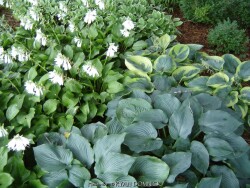

Hosta by far is the most popular and well-known shade plant in the United States. Many thousands of cultivars exist from original species native to China, Japan, and other forested areas in Asia. Hosta foliage arrises from a clump-forming root system and is often large and dramatic with many types of variegation. Flowers, born on tall stocks ranging in shades of white and purple, are equally attractive. Hostas grow best in rich, well-drained soils in full to partial shade. In Eastern Kansas with our average 40 inches of average rainfall, plants are drought tolerant if established in moisture-retentive high-quality soil. Dry-shade areas are best avoided. Afternoon sun with temperatures over 95 degrees F but likely burn the tips of hosta foliage rendering them unattractive for the rest of the year. There is no secondary growth by late summer after flowering and after buds have been set for next year. In northern parts of the country, hostas can handle full sun. In the Southern part of their range further South than zone 7, hosta can really struggle through the long summer heat unless conditions are perfect. Rabbits, deer, slugs, and snails can be a problem generally on small or un-established plants. Large-leaf robust varieties seem to outgrow browsing predators better than small dainty varieties. Methods of control are effective ranging from cages to deer repellents. Generally, a large established planting of hostas will be there for decades gradually getting thicker and denser without a need to divide. Many plantings have been in our display garden for 15-20 years with no weeds ever trying to grow in the shade of the foliage. Hosta foliage is susceptible to late spring freezes so try to cover if possible. During the Easter freeze of April, 2007, thousands of hosta were killed to the ground in eastern Kansas but all returned successfully by May from secondary buds. Hosta's newly unfurling foliage is considered edible when cooked like asparagus or eaten raw in salads. Hosta 'T-Rex' is a giant. It forms absolutely huge clumps of blue-green leaves measuring 18" long and 14"wide! Wonderful puckering and deep veins add interest, a focal point for any garden. Near white flowers.
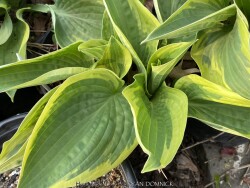

Hosta by far is the most popular and well-known shade plant in the United States. Many thousands of cultivars exist from original species native to China, Japan, and other forested areas in Asia. Hosta foliage arrises from a clump-forming root system and is often large and dramatic with many types of variegation. Flowers, born on tall stocks ranging in shades of white and purple, are equally attractive. Hostas grow best in rich, well-drained soils in full to partial shade. In Eastern Kansas with our average 40 inches of average rainfall, plants are drought tolerant if established in moisture-retentive high-quality soil. Dry-shade areas are best avoided. Afternoon sun with temperatures over 95 degrees F but likely burn the tips of hosta foliage rendering them unattractive for the rest of the year. There is no secondary growth by late summer after flowering and after buds have been set for next year. In northern parts of the country, hostas can handle full sun. In the Southern part of their range further South than zone 7, hosta can really struggle through the long summer heat unless conditions are perfect. Rabbits, deer, slugs, and snails can be a problem generally on small or un-established plants. Large-leaf robust varieties seem to outgrow browsing predators better than small dainty varieties. Methods of control are effective ranging from cages to deer repellents. Generally, a large established planting of hostas will be there for decades gradually getting thicker and denser without a need to divide. Many plantings have been in our display garden for 15-20 years with no weeds ever trying to grow in the shade of the foliage. Hosta foliage is susceptible to late spring freezes so try to cover if possible. During the Easter freeze of April, 2007, thousands of hosta were killed to the ground in eastern Kansas but all returned successfully by May from secondary buds. Hosta's newly unfurling foliage is considered edible when cooked like asparagus or eaten raw in salads. Hosta 'Wide Brim' is a medium variety with heart-shaped green leaves with wide irregular creamy-yellow margins. Good substance with slight puckering under pale lavender flowers.
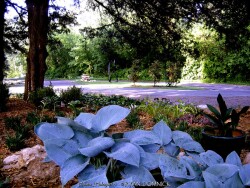

Hosta by far is the most popular and well-known shade plant in the United States. Many thousands of cultivars exist from original species native to China, Japan, and other forested areas in Asia. Hosta foliage arrises from a clump-forming root system and is often large and dramatic with many types of variegation. Flowers, born on tall stocks ranging in shades of white and purple, are equally attractive. Hostas grow best in rich, well-drained soils in full to partial shade. In Eastern Kansas with our average 40 inches of average rainfall, plants are drought tolerant if established in moisture-retentive high-quality soil. Dry-shade areas are best avoided. Afternoon sun with temperatures over 95 degrees F but likely burn the tips of hosta foliage rendering them unattractive for the rest of the year. There is no secondary growth by late summer after flowering and after buds have been set for next year. In northern parts of the country, hostas can handle full sun. In the Southern part of their range further South than zone 7, hosta can really struggle through the long summer heat unless conditions are perfect. Rabbits, deer, slugs, and snails can be a problem generally on small or un-established plants. Large-leaf robust varieties seem to outgrow browsing predators better than small dainty varieties. Methods of control are effective ranging from cages to deer repellents. Generally, a large established planting of hostas will be there for decades gradually getting thicker and denser without a need to divide. Many plantings have been in our display garden for 15-20 years with no weeds ever trying to grow in the shade of the foliage. Hosta foliage is susceptible to late spring freezes so try to cover if possible. During the Easter freeze of April, 2007, thousands of hosta were killed to the ground in eastern Kansas but all returned successfully by May from secondary buds. Hosta's newly unfurling foliage is considered edible when cooked like asparagus or eaten raw in salads.
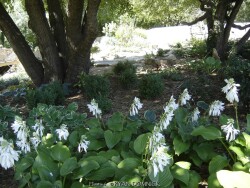

Hosta by far is the most popular and well-known shade plant in the United States. Many thousands of cultivars exist from original species native to China, Japan, and other forested areas in Asia. Hosta foliage arrises from a clump-forming root system and is often large and dramatic with many types of variegation. Flowers, born on tall stocks ranging in shades of white and purple, are equally attractive. Hostas grow best in rich, well-drained soils in full to partial shade. In Eastern Kansas with our average 40 inches of average rainfall, plants are drought tolerant if established in moisture-retentive high-quality soil. Dry-shade areas are best avoided. Afternoon sun with temperatures over 95 degrees F but likely burn the tips of hosta foliage rendering them unattractive for the rest of the year. There is no secondary growth by late summer after flowering and after buds have been set for next year. In northern parts of the country, hostas can handle full sun. In the Southern part of their range further South than zone 7, hosta can really struggle through the long summer heat unless conditions are perfect. Rabbits, deer, slugs, and snails can be a problem generally on small or un-established plants. Large-leaf robust varieties seem to outgrow browsing predators better than small dainty varieties. Methods of control are effective ranging from cages to deer repellents. Generally, a large established planting of hostas will be there for decades gradually getting thicker and denser without a need to divide. Many plantings have been in our display garden for 15-20 years with no weeds ever trying to grow in the shade of the foliage. Hosta foliage is susceptible to late spring freezes so try to cover if possible. During the Easter freeze of April, 2007, thousands of hosta were killed to the ground in eastern Kansas but all returned successfully by May from secondary buds. Hosta's newly unfurling foliage is considered edible when cooked like asparagus or eaten raw in salads.
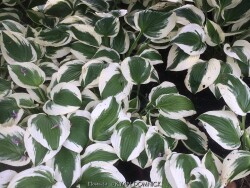

Hosta by far is the most popular and well-known shade plant in the United States. Many thousands of cultivars exist from original species native to China, Japan, and other forested areas in Asia. Hosta foliage arrises from a clump-forming root system and is often large and dramatic with many types of variegation. Flowers, born on tall stocks ranging in shades of white and purple, are equally attractive. Hostas grow best in rich, well-drained soils in full to partial shade. In Eastern Kansas with our average 40 inches of average rainfall, plants are drought tolerant if established in moisture-retentive high-quality soil. Dry-shade areas are best avoided. Afternoon sun with temperatures over 95 degrees F but likely burn the tips of hosta foliage rendering them unattractive for the rest of the year. There is no secondary growth by late summer after flowering and after buds have been set for next year. In northern parts of the country, hostas can handle full sun. In the Southern part of their range further South than zone 7, hosta can really struggle through the long summer heat unless conditions are perfect. Rabbits, deer, slugs, and snails can be a problem generally on small or un-established plants. Large-leaf robust varieties seem to outgrow browsing predators better than small dainty varieties. Methods of control are effective ranging from cages to deer repellents. Generally, a large established planting of hostas will be there for decades gradually getting thicker and denser without a need to divide. Many plantings have been in our display garden for 15-20 years with no weeds ever trying to grow in the shade of the foliage. Hosta foliage is susceptible to late spring freezes so try to cover if possible. During the Easter freeze of April, 2007, thousands of hosta were killed to the ground in eastern Kansas but all returned successfully by May from secondary buds. Hosta's newly unfurling foliage is considered edible when cooked like asparagus or eaten raw in salads.
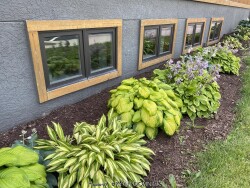

Hosta by far is the most popular and well-known shade plant in the United States. Many thousands of cultivars exist from original species native to China, Japan, and other forested areas in Asia. Hosta foliage arrises from a clump-forming root system and is often large and dramatic with many types of variegation. Flowers, born on tall stocks ranging in shades of white and purple, are equally attractive. Hostas grow best in rich, well-drained soils in full to partial shade. In Eastern Kansas with our average 40 inches of average rainfall, plants are drought tolerant if established in moisture-retentive high-quality soil. Dry-shade areas are best avoided. Afternoon sun with temperatures over 95 degrees F but likely burn the tips of hosta foliage rendering them unattractive for the rest of the year. There is no secondary growth by late summer after flowering and after buds have been set for next year. In northern parts of the country, hostas can handle full sun. In the Southern part of their range further South than zone 7, hosta can really struggle through the long summer heat unless conditions are perfect. Rabbits, deer, slugs, and snails can be a problem generally on small or un-established plants. Large-leaf robust varieties seem to outgrow browsing predators better than small dainty varieties. Methods of control are effective ranging from cages to deer repellents. Generally, a large established planting of hostas will be there for decades gradually getting thicker and denser without a need to divide. Many plantings have been in our display garden for 15-20 years with no weeds ever trying to grow in the shade of the foliage. Hosta foliage is susceptible to late spring freezes so try to cover if possible. During the Easter freeze of April, 2007, thousands of hosta were killed to the ground in eastern Kansas but all returned successfully by May from secondary buds. Hosta's newly unfurling foliage is considered edible when cooked like asparagus or eaten raw in salads.


Hosta by far is the most popular and well-known shade plant in the United States. Many thousands of cultivars exist from original species native to China, Japan, and other forested areas in Asia. Hosta foliage arrises from a clump-forming root system and is often large and dramatic with many types of variegation. Flowers, born on tall stocks ranging in shades of white and purple, are equally attractive. Hostas grow best in rich, well-drained soils in full to partial shade. In Eastern Kansas with our average 40 inches of average rainfall, plants are drought tolerant if established in moisture-retentive high-quality soil. Dry-shade areas are best avoided. Afternoon sun with temperatures over 95 degrees F but likely burn the tips of hosta foliage rendering them unattractive for the rest of the year. There is no secondary growth by late summer after flowering and after buds have been set for next year. In northern parts of the country, hostas can handle full sun. In the Southern part of their range further South than zone 7, hosta can really struggle through the long summer heat unless conditions are perfect. Rabbits, deer, slugs, and snails can be a problem generally on small or un-established plants. Large-leaf robust varieties seem to outgrow browsing predators better than small dainty varieties. Methods of control are effective ranging from cages to deer repellents. Generally, a large established planting of hostas will be there for decades gradually getting thicker and denser without a need to divide. Many plantings have been in our display garden for 15-20 years with no weeds ever trying to grow in the shade of the foliage. Hosta foliage is susceptible to late spring freezes so try to cover if possible. During the Easter freeze of April, 2007, thousands of hosta were killed to the ground in eastern Kansas but all returned successfully by May from secondary buds. Hosta's newly unfurling foliage is considered edible when cooked like asparagus or eaten raw in salads.
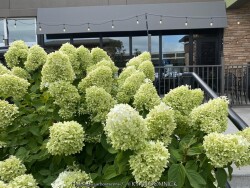

***Description for this plant available with future update!***>>>>> Spring Meadows nursery says "Literally, a huge improvement over 'Annabelle'! Our goal in creating Incrediball® hydrangea was to develop a non-flopping version of 'Annabelle.' What we ultimately selected, though, was even better: a powerhouse of a plant that not only has strong, sturdy, supportive stems, but also extra large flowers. On mature plants, they can become as large as basketballs! Blooms age to a beautiful jade green through summer and fall. Don't let its good looks fool you, though - this North American native is super hardy and tough as nails."
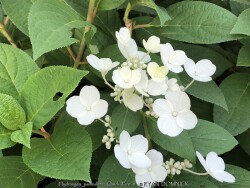

Quick Fire Fab® Panicle Hydrangea (Hydrangea paniculata 'Quick Fire Fab') is the first to bloom! Quick Fire blooms about a month before any other panicle hydrangea. Flowers open pure white then turn pink, and will be an extremely dark rosy-pink in the fall. The flower color on Quick Fire hydrangea is not affected by soil pH. Blooms on this super-hardy and easy to grow hydrangea are produced on new wood, which means that you will see flowers even after even the harshest winters. Beautiful for use as a cut (fresh or dried) flower. Unlike other panicle hydrangeas, Quick Fire Fab also has excellent fall foliage color for a final hurrah before winter. This is a very hardy flowering shrub good for full sun locations - the hotter your climate, however, the more shade the plant will require. Good for groupings and in mass plantings, shrub and perennial borders, as a specimen, a screen or a hedge. Panicle hydrangeas like Quick Fire Fab are very easy to care for. They can grow in most soils, provided they are well-drained. Panicle hydrangeas bloom on new wood, which means they can be pruned in spring and will still bloom that season. We recommend cutting them back by about one-third their total height in early spring, just as the new growth is beginning to emerge on the stems. This will serve to remove the spent blooms and ensure that the season's growth comes from the heavier, thicker buds further down the plant. If blooms do not age to pink and red, this indicates that the plant is either in too much shade, that it experienced drought stress, or that night time temperatures were unusually high. In Eastern Kansas, this cultivar performs reasonably well. Heat and drought are tolerated if in morning sun. In full sun provide ample water and expect some leaf burn if summer temperatures exceed 100 degrees F. Cold tolerance is no problem. No disease or pest problems. All Proven Winners® plants are legally propagated, healthy and vigorous, true to name, and tagged with color pictures and growing information.
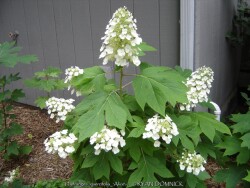

>>>>>Oakleaf hydrangea (Hydrangea quercifolia) is a large coarse-textured deciduous shrub growing to 3-10 feet tall with an open crown native to the southeastern United States. Cone-shaped flower clusters emerge bright white in mid-summer. Flowers age to progressively darker shades of pink and by autumn and become persistent dried flower-heads in winter. The leaves are dark green on top and silvery-white underneath. Plants in shade have larger leaves than those grown in sun. In sun, if drought stress occurs, foliage becomes tattered, burnt, and yellowish; ruining potential fall color. The leaves of healthy plants turn rich shades of red, bronze and purple in autumn that persist until about 25 degrees F usually into late November in Kansas. The plant slowly sprouts shoots from underground stolons and often grows in colonies in ideal conditions but this is rare in Kansas. Young stems are covered in a felt-like light brown bark while the larger stems develop an attractive cinnamon-tan-orange bark that shreds and peels in thin flakes. Hydrangea quercifolia is best grown in rich, medium moisture, well-drained soils in part shade. Drought and full sun tolerance are average but greatly improved with rich, moisture-retentive foresty soils. Plant near gutter downspouts for an extra boost of water. It will tolerate drought, but may not flower. In Eastern Kansas, Cold tolerance is no problem. No significant disease or pest problems. Of all the hydrangeas, this is probably the toughest! Several improved cultivars have been developed.
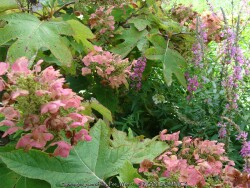

>>>>>Oakleaf hydrangea (Hydrangea quercifolia) is a large coarse-textured deciduous shrub growing to 3-10 feet tall with an open crown native to the southeastern United States. Cone-shaped flower clusters emerge bright white in mid-summer. Flowers age to progressively darker shades of pink and by autumn and become persistent dried flower-heads in winter. The leaves are dark green on top and silvery-white underneath. Plants in shade have larger leaves than those grown in sun. In sun, if drought stress occurs, foliage becomes tattered, burnt, and yellowish; ruining potential fall color. The leaves of healthy plants turn rich shades of red, bronze and purple in autumn that persist until about 25 degrees F usually into late November in Kansas. The plant slowly sprouts shoots from underground stolons and often grows in colonies in ideal conditions but this is rare in Kansas. Young stems are covered in a felt-like light brown bark while the larger stems develop an attractive cinnamon-tan-orange bark that shreds and peels in thin flakes. Hydrangea quercifolia is best grown in rich, medium moisture, well-drained soils in part shade. Drought and full sun tolerance are average but greatly improved with rich, moisture-retentive foresty soils. Plant near gutter downspouts for an extra boost of water. It will tolerate drought, but may not flower. In Eastern Kansas, Cold tolerance is no problem. No significant disease or pest problems. Of all the hydrangeas, this is probably the toughest! Several improved cultivars have been developed.
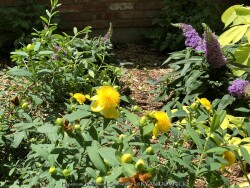

Sunburst Hypericum, is also known as Hypericum frondosum 'Sunburst'
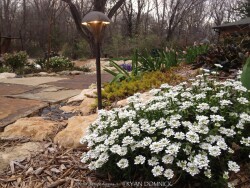

***Description for this perennial available with future update!***
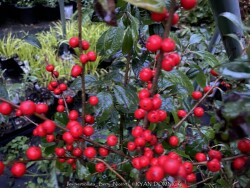

Berry Poppins & Mr. Poppins Combo Winterberry, is also known as Ilex verticillata 'Berry Poppins & Mr. Poppins'
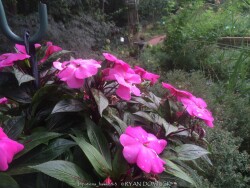

***Description for this plant available with future update!***
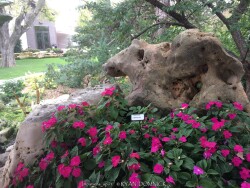

***Description for this plant available with future update!*** This plant can also be used as a marginal aquatic plant growing in shallow water. It can also grow as a bog plant needing constantly moist soil rich in organic matter. As a rain garden plant, it will thrive is a depressed area in the landscape that collects rain water from a roof during spring and summer periods of rain but then go dormant if the water hole dries out completely.
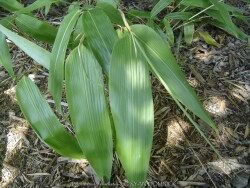

Largeleaf Groundcover Bamboo / Indocalamus, is also known as Indocalamus tessellatus
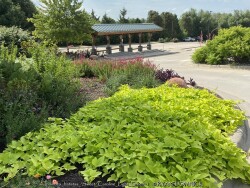

Gold Sweet Potato Vine (Ipomoea batatas 'Sweet Caroline Light Green') is one of the most rapidly growing annuals in out library: it can fill a large annual planting bed after 1 month when planted in May and taking advantage of early summer rains, heat and humidity. It is also great cascading down retaining walls or large pots! Occasional pink flowers do occur but are usually second place behind the attractive foliage. It can handle some drought due to its "sweet potato" underground tuber! It can also be a patio plant, house plant, or hanging basket. If growing as a potted plant and trying to overwinter, allowing the foliage to frost is ok, it will not kill the root system. However, do not allow the pot with rootball to freeze solid or go below 30 degrees for more than a few hours; move into a cold garage or basement over the winter with minimal watering. Allow to go dormant as needed with little care, just cut off dead foliage and place back out in April or May with a time-release fertilizer.
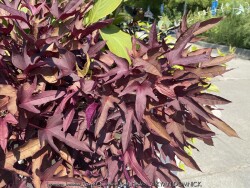

Reddish Purple Sweet Potato Vine (Ipomoea batatas 'Sweet Caroline Red Hawk') is one of the most rapidly growing annuals in out library: it can fill a large annual planting bed after 1 month when planted in May and taking advantage of early summer rains, heat and humidity. It is also great cascading down retaining walls or large pots! Occasional pink flowers do occur but are usually second place behind the attractive foliage. It can handle some drought due to its "sweet potato" underground tuber! It can also be a patio plant, house plant, or hanging basket. If growing as a potted plant and trying to overwinter, allowing the foliage to frost is ok, it will not kill the root system. However, do not allow the pot with rootball to freeze solid or go below 30 degrees for more than a few hours; move into a cold garage or basement over the winter with minimal watering. Allow to go dormant as needed with little care, just cut off dead foliage and place back out in April or May with a time-release fertilizer.
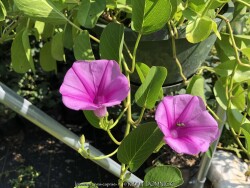

Beach Morning Glory / Railroad Vine (Ipomoea pes-caprae) is the most rapidly growing annual in out library capable of growing 30-50' in one summer! (100-200' in native coastal dune habitats) It can fill a large annual planting bed with bright green foliage after 1 month when planted in May and taking advantage of early summer rains, heat and humidity. It is also great cascading down retaining walls or large pots! Deep root system will grow in pure sand or typical garden soil provided that regular moisture is available. In Eastern Kansas, typically our 40 inches of rainfall is sufficient without extra water in good soils. The magenta flowers are 2-3" across and absolutely beautiful and will get noticed; blooms sporadically in early summer but covered by late summer and early fall in Kansas. Who would have thought that a coastal sand dune stabilization plant would thrive or even grow at all in Kansas? It has been trialed here as a hanging basket plant, cascading wall plant, and mass groundcover in annual beds. If growing as a potted plant and trying to overwinter, it is very difficult as these plants do not like low humidity or low light; best to replace each year.
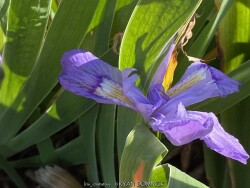

***Description for this perennial available with future update!***
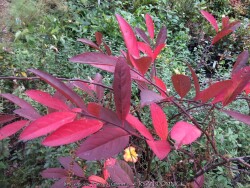

Virginia sweetspire (Itea virginica) is a native shrub found along creeks and streams in the eastern United States. Foliage consists of a simple leaf, medium to light green, and usually glossy. White cascading flowers cover the plants in spring for about a month with pollinators flocking to the occasion. Fall color is outstanding shades of red and purple. Leaves cling to the stem and are very persistent down to about 10-15°F often finally dropping in December. Stems during the winter take on an attractive reddish-brown and green coloring. Sweetspire is truly a four-season shrub! In the landscape, combine with native plants, hardy tropicals, or summer flowering plants. These plants can tolerate saturated soils and are perfect for rain gardens or any other rich soil garden areas. North exposures are fine in zone 6 but not any further north as winter kill becomes a problem in zone 5. Water is usually the limiting factor in southern climates zone 7-9. Sweetspire is highly sensitive to iron chlorosis so avoid alkaline soils. In our eastern Kansas climate, we avoid afternoon sun and dry soils. Full shade is tolerated but not dry shade. Fall color will be reduced or nonexistent in full shade. Morning sun is best for avoiding leaf burn but still allowing fall coloring. Overall, this is a great garden plant when sited in the right conditions. Itea virginica 'Henry's Garnet' has larger flowers and better fall color compared to the species.
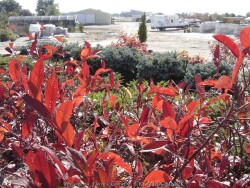

Virginia sweetspire (Itea virginica) is a native shrub found along creeks and streams in the eastern United States. Foliage consists of a simple leaf, medium to light green, and usually glossy. White cascading flowers cover the plants in spring for about a month with pollinators flocking to the occasion. Fall color is outstanding shades of red and purple. Leaves cling to the stem and are very persistent down to about 10-15°F often finally dropping in December. Stems during the winter take on an attractive reddish-brown and green coloring. Sweetspire is truly a four-season shrub! In the landscape, combine with native plants, hardy tropicals, or summer flowering plants. These plants can tolerate saturated soils and are perfect for rain gardens or any other rich soil garden areas. North exposures are fine in zone 6 but not any further north as winter kill becomes a problem in zone 5. Water is usually the limiting factor in southern climates zone 7-9. Sweetspire is highly sensitive to iron chlorosis so avoid alkaline soils. In our eastern Kansas climate, we avoid afternoon sun and dry soils. Full shade is tolerated but not dry shade. Fall color will be reduced or nonexistent in full shade. Morning sun is best for avoiding leaf burn but still allowing fall coloring. Overall, this is a great garden plant when sited in the right conditions. Itea virginica 'Merlot' features more mounded, compact stature and more persistant burgundy fall color making it an improvement over older varieties such as the old favorite 'Henry's Garnet'. Flowers are scented!
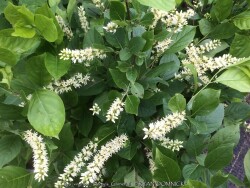

Virginia sweetspire (Itea virginica) is a native shrub found along creeks and streams in the eastern United States. Foliage consists of a simple leaf, medium to light green, and usually glossy. White cascading flowers cover the plants in spring for about a month with pollinators flocking to the occasion. Fall color is outstanding shades of red and purple. Leaves cling to the stem and are very persistent down to about 10-15°F often finally dropping in December. Stems during the winter take on an attractive reddish-brown and green coloring. Sweetspire is truly a four-season shrub! In the landscape, combine with native plants, hardy tropicals, or summer flowering plants. These plants can tolerate saturated soils and are perfect for rain gardens or any other rich soil garden areas. North exposures are fine in zone 6 but not any further north as winter kill becomes a problem in zone 5. Water is usually the limiting factor in southern climates zone 7-9. Sweetspire is highly sensitive to iron chlorosis so avoid alkaline soils. In our eastern Kansas climate, we avoid afternoon sun and dry soils. Full shade is tolerated but not dry shade. Fall color will be reduced or nonexistent in full shade. Morning sun is best for avoiding leaf burn but still allowing fall coloring. Overall, this is a great garden plant when sited in the right conditions. Itea virginica 'Scentlandia' adds sweet summertime fragrance to the host of other improvements like compact growth, improved flowerbud hardiness, and improved red fall color. All Proven Winners® plants are legally propagated, healthy and vigorous, true to name, and tagged with color pictures and growing information.
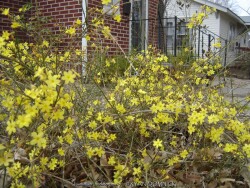

Winter Jasmine (Jasminium nudiflorum) is a spreading dwarf shrub native to China. It features dark green glossy leaves that remain attractive all summer. The density of the shrub overtime is unmatched, completely eliminating any weeds including tree seedlings from emerging. Bright yellow five-petaled flowers resembling forsythia bloom extremely early in the spring usually in February or March before foliage growth (in Lawrence, KS). Flower buds are hardy to about 0° so flowering may not occur every year if temperatures get lower. Occasionally this shrub will bloom in the middle of winter when we have a 2-3 week warm spell. When it does bloom, it creates a spectacular show completely covering the shrub. It will grow in full sun or full shade in medium to dry soils including some dry-shade. It tolerates moist soils and brief periods of saturated soils after heavy rains. Fall color is yellow but drops quickly. Stems take on an olive greenish color in winter rendering them mildly attractive. Winter jasmine is commonly grown as a spreading groundcover shrub for difficult areas, frequently used as large mass planting on hills. Because of its tolerance for adverse conditions including poor soil and rock, it is often one of the last resort plants that will survive in certain areas. It competes well under large shade trees and helps absorb leaf litter allowing it to break down and add nutrients back to the soil. This plant also does well in hot dry parking lot islands, hell strips, and along busy roads in full sun. Another great spot is planting on top of a retaining wall allowing it to cascade down. Further uses include erosion control and streambank stabilization. We do not recommend planting in small areas or in spaces that it will overrun neighboring plants. It only spreads above ground as horizontally growing stems touch the ground and root. This does make maintenance easier to control the spread of the plant versus digging out rhizomes. Avoid North exposures and wet soils. Considered one of the most versatile and best plants for solving difficult landscape challenges.
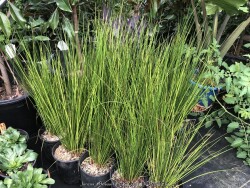

>>>>>This plant can also be used as a marginal aquatic plant growing in shallow water. It can also grow as a bog plant needing constantly moist soil rich in organic matter. As a rain garden plant, it will thrive is a depressed area in the landscape that collects rain water from a roof during spring and summer periods of rain but then go dormant if the water hole dries out completely.
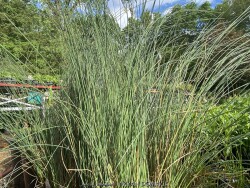

>>>>>This plant can also be used as a marginal aquatic plant growing in shallow water. It can also grow as a bog plant needing constantly moist soil rich in organic matter. As a rain garden plant, it will thrive is a depressed area in the landscape that collects rain water from a roof during spring and summer periods of rain but then go dormant if the water hole dries out completely.
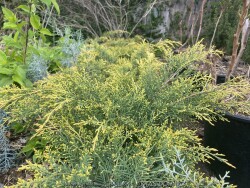

***Shrub descriptions available with future update!***
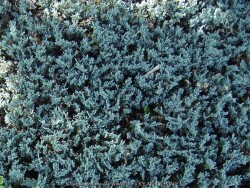

***Shrub descriptions available with future update!***
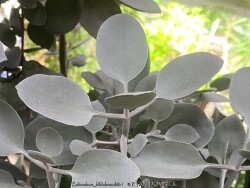

The silver foliage color of (Kalanchoe hildebrandtii) steals the show. Usually used as a patio or house plant in Kansas, they can also be grown as an annual if purchased in bulk. Grow in full sun to part sun with optional extra watering including that which comes from rainfall. Plants with time to acclimate will thrive in full sun but be careful not to rush it or sunburning will occur. Generally if moving outside for the summer, allow 2-3 weeks of part shade or morning sun before placing in full sun. Repotting may or may not be needed depending on how large you want the plant to grow; plants can continue to grow and tolerate extremely root-bound pots. Protect from temperatures below 35 degrees F and move into a bright window over the winter with no watering. Do not allow Silver Teaspoons plant grown in pots to freeze solid or get close to freezing especially if soil is wet or death may occur. As a winter house plant, it will look presentable all winter long with just a few monthly or almost no waterings if you forget. As a permanent house plant, provide bright light and allow the soil to dry between waterings for many years of carefree enjoyment. Potted plants are very low maintenance and tolerant of indoor environments. This is not at all a big-box store plant so be prepared to expand your plant palette with Silver Teaspoons!


The foliage color, texture and patterns make Paddle Plant (Kalanchoe luciae) an excellent architectural specimen. Usually used as a patio or house plant in Kansas, they can also be grown as an annual. Grow in full sun to part sun with optional extra watering including that which comes from rainfall. Plants with time to acclimate will thrive in full sun but be careful not to rush it or sunburning will occur. Generally if moving outside for the summer, allow 2-3 weeks of part shade or morning sun before placing in full sun. Repotting may or may not be needed depending on how large you want the plant to grow; plants can continue to grow and tolerate extremely root-bound pots. Protect from temperatures below 35 degrees F and move into a bright window over the winter with no watering. Do not allow Paddle plant grown in pots to freeze solid or get close to freezing especially if soil is wet or death may occur. As a winter house plant, it will look presentable all winter long with just a few monthly or no waterings if you forget. As a permanent house plant, provide bright light and allow the soil to dry between waterings for many years of carefree enjoyment. Potted plants are very low maintenance needing only old leaves trimmed once per year. This is not at all a big-box store plant so be prepared to expand your plant palette with Paddle plant!
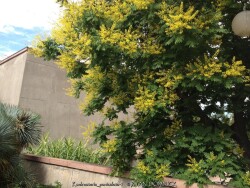

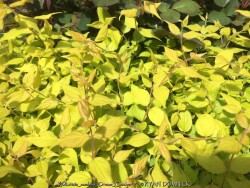

Dream Catcher Beautybush, is also known as Kolkwitzia amabilis 'Dream Catcher'
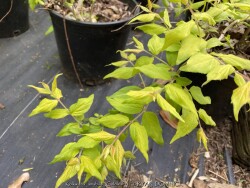

Goldleaf/Golden Beauty Beautybush, is also known as Kolkwitzia amabilis 'Goldleaf'